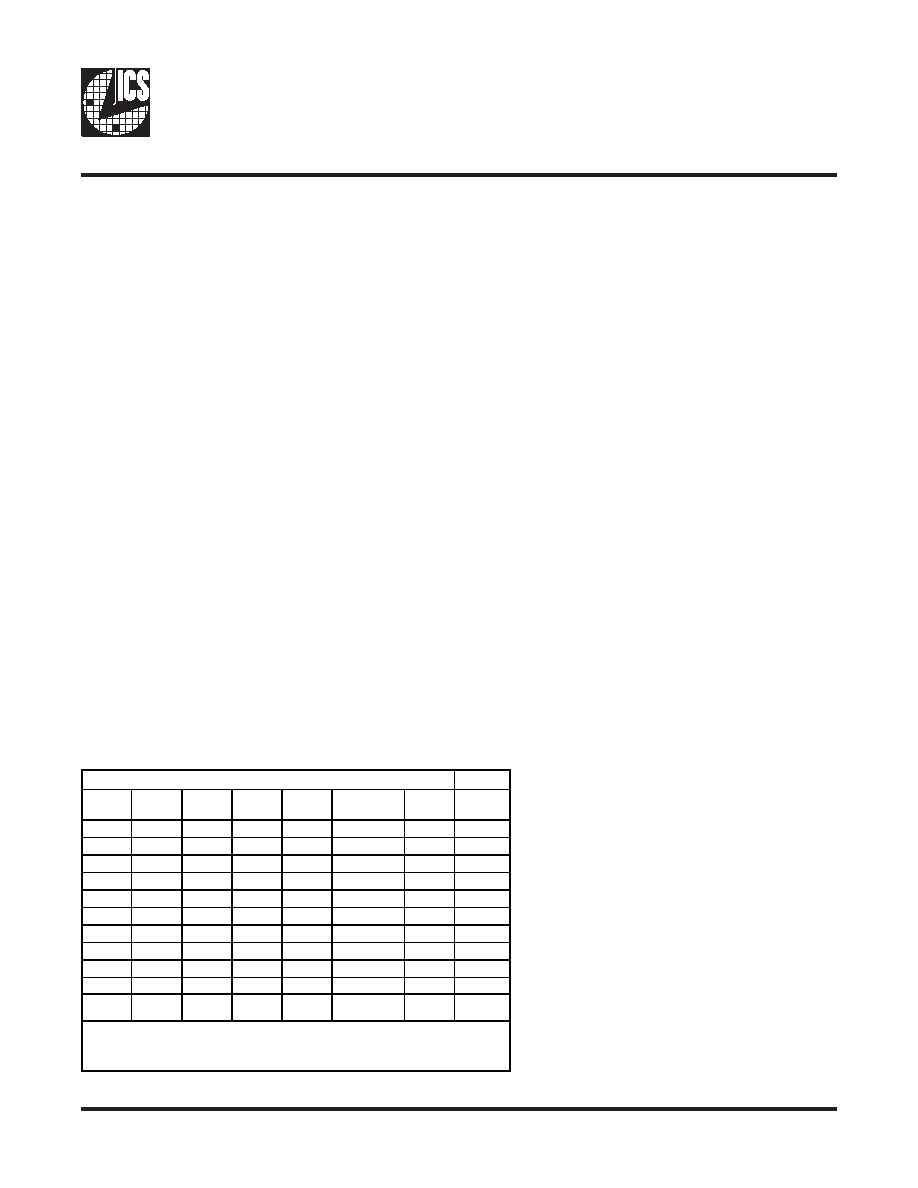- 您現(xiàn)在的位置:買賣IC網(wǎng) > PDF目錄67710 > ICSSSTUA32S865AHLF-T (INTEGRATED DEVICE TECHNOLOGY INC) SSTU SERIES, POSITIVE EDGE TRIGGERED D FLIP-FLOP, TRUE OUTPUT, PBGA160 PDF資料下載
參數(shù)資料
| 型號(hào): | ICSSSTUA32S865AHLF-T |
| 廠商: | INTEGRATED DEVICE TECHNOLOGY INC |
| 元件分類: | 鎖存器 |
| 英文描述: | SSTU SERIES, POSITIVE EDGE TRIGGERED D FLIP-FLOP, TRUE OUTPUT, PBGA160 |
| 封裝: | 9 X 13 MM, LEAD FREE, BGA-160 |
| 文件頁(yè)數(shù): | 11/17頁(yè) |
| 文件大小: | 199K |
| 代理商: | ICSSSTUA32S865AHLF-T |
第1頁(yè)第2頁(yè)第3頁(yè)第4頁(yè)第5頁(yè)第6頁(yè)第7頁(yè)第8頁(yè)第9頁(yè)第10頁(yè)當(dāng)前第11頁(yè)第12頁(yè)第13頁(yè)第14頁(yè)第15頁(yè)第16頁(yè)第17頁(yè)

3
ICSSSTUA32S865A
1053A—03/21/05
General Description
This 28-bit 1:2 registered buffer with parity is designed for 1.7V to 1.9V VDD operation.
All clock and data inputs are compatible with the JEDEC standard for SSTL_18. The control inputs are
LVCMOS. All outputs are 1.8 V CMOS drivers that have been optimized to drive the DDR2 DIMM load.
The ICSSSTUA32S865A operates from a differential clock (CK and CK#). Data are registered at the crossing of CK
going high, and CK# going low.
The device supports low-power standby operation. When the reset input (RESET#) is low, the differential
input receivers are disabled, and undriven (floating) data, clock and reference voltage (VREF) inputs are
allowed. In addition, when RESET# is low all registers are reset, and all outputs except PTYERR# are forced
low. The LVCMOS RESET# input must always be held at a valid logic high or low level.
To ensure defined outputs from the register before a stable clock has been supplied, RESET# must be held
in the low state during power up.
In the DDR2 RDIMM application, RESET# is specified to be completely asynchronous with respect to CK
and CK#. Therefore, no timing relationship can be guaranteed between the two. When entering reset, the
register will be cleared and the outputs will be driven low quickly, relative to the time to disable the
differential input receivers. However, when coming out of reset, the register will become active quickly,
relative to the time to enable the differential input receivers. As long as the data inputs are low, and the
clock is stable during the time from the low-to-high transition of RESET# until the input receivers are fully
enabled, the design of the ICSSSTUA32S865A must ensure that the outputs will remain low, thus ensuring no
glitches on the output.
The device monitors both DCS0# and DCS1# inputs and will gate the Qn outputs from changing states when
both DCS0# and DCS1# are high. If either DCS0# or DCS1# input is low, the Qn outputs will function
normally. The RESET# input has priority over the DCS0# and DCS1# control and will force the Qn outputs
low and the PTYERR# output high. If the DCS-control functionality is not desired, then the CSGateEnable
input can be hardwired to ground, in which case, the setup-time requirement for DCS would be the same as
for the other D data inputs.
The ICSSSTUA32S865A includes a parity checking function. The ICSSSTUA32S865A accepts a parity bit from the
memory controller at its input pin PARIN, compares it with the data received on the D-inputs and indicates
whether a parity error has occurred on its open-drain PTYERR# pin (active LOW).
Package options include 160-ball Thin Profile Fine Pitch BGA (TFBGA) (12 X 18 array, 9.0 X 13.0 mm
body size, 0.65 mm pitch, MO-246, Issue A).
Inputs
Output
RESET#
DCS0#
DCS1#
CK
CK#
of inputs = H
(D0-D21)
PARIN*
PTYERR#**
H
LH
Even
L
H
LH
Odd
L
HLH
Even
H
L
H
LH
Odd
H
HL
Even
L
H
HH
L
Odd
L
H
HL
Even
H
L
H
HL
Odd
H
HH
XX
PTYERR#0
H
X
L or H
X
L
X or
floating
X or
floating
X or
floating
X or
floating
X or floating
X or
floating
H
*
PARIN arrives one clock cycle after the data to which it applies.
** This transition assumes PTYERR# is high at the crossing of CK going high and CK# going low. If PTYERR#
is low, it stays latched low for two clock cycles or until RESET# is driven low.
↑
↓
↑
↓
↑
↓
↑
↓
↑
↓
↑
↓
↑
↓
↑
↓
↑
↓
相關(guān)PDF資料 |
PDF描述 |
|---|---|
| ICSSSTUB32871AHMLFT | 32871 SERIES, POSITIVE EDGE TRIGGERED D FLIP-FLOP, TRUE OUTPUT, PBGA96 |
| ICSSSTUF32864AYH-T | SSTU SERIES, POSITIVE EDGE TRIGGERED D FLIP-FLOP, TRUE OUTPUT, PBGA96 |
| ICSSSTUF32864AYHLF-T | SSTU SERIES, POSITIVE EDGE TRIGGERED D FLIP-FLOP, TRUE OUTPUT, PBGA96 |
| ICSSSTUF32864AYHLF-T | SSTU SERIES, POSITIVE EDGE TRIGGERED D FLIP-FLOP, TRUE OUTPUT, PBGA96 |
| ICSSSTUF32864YHLFT | SSTU SERIES, POSITIVE EDGE TRIGGERED D FLIP-FLOP, TRUE OUTPUT, PBGA96 |
相關(guān)代理商/技術(shù)參數(shù) |
參數(shù)描述 |
|---|---|
| ICSSSTUA32S869B | 制造商:ICS 制造商全稱:ICS 功能描述:14-Bit Configurable Registered Buffer for DDR2 |
| ICSSSTUAF32865A | 制造商:IDT 制造商全稱:Integrated Device Technology 功能描述:25-BIT CONFIGURABLE REGISTERED BUFFER FOR DDR2 |
| ICSSSTUAF32865AHLFT | 制造商:IDT 制造商全稱:Integrated Device Technology 功能描述:25-BIT CONFIGURABLE REGISTERED BUFFER FOR DDR2 |
| ICSSSTUAF32866B | 制造商:IDT 制造商全稱:Integrated Device Technology 功能描述:25-BIT CONFIGURABLE REGISTERED BUFFER FOR DDR2 |
| ICSSSTUAF32866BHLFT | 制造商:IDT 制造商全稱:Integrated Device Technology 功能描述:25-BIT CONFIGURABLE REGISTERED BUFFER FOR DDR2 |
發(fā)布緊急采購(gòu),3分鐘左右您將得到回復(fù)。